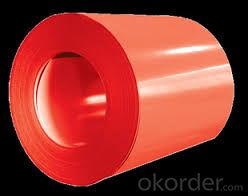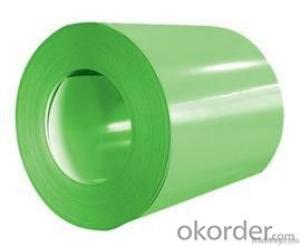prepainted galvanized Rolled Steel Coil-DX51D
- Loading Port:
- Tianjin
- Payment Terms:
- TT OR LC
- Min Order Qty:
- 100 m.t.
- Supply Capability:
- 500000 m.t./month
OKorder Service Pledge
OKorder Financial Service
You Might Also Like
Brief Introduction
Prepainted Galvanized Steel usually refers to have substrateprocessed with surface processed and coated then(roller coated )or bonded organic thin film and baked, and it is able to be processed tofinal prodevtion .
PrepaintedGalvanized Steel qualified with excellent decorative ,formability ,corrosionresistance ,coating adhesion ,can keep for a long time as well as maintainfresh color .For color coated steel sheet can obtain good economicbenefit by steel belt wood ,efficient in construction and save energy ,preventpollution etc.Which is an ideal material;for manufacturing board.
Sample Charge
1.Samples charge:According to your requirements . Sampling time:30days with minimum qty order.
2.Samples charge:Free for Existing Samples Sampling time:1day
Advantage
1. Low MOQ: We will do our best to make you satisfied.
2.Good Service : We treat clients as friend.
3.Good Quality :We have strict quality control system .Good reputation in the market.
4.Fast & Cheap Delivery: We have big discount from forwarder (Long Contract).
5.Supply Ability: 50000 ton monthly
Technical Data Of Prepainted Galvanized Steel
Yield Strength | (Mpa) 280-320 |
Tensile Strength | (Mpa) 340-390 |
Elongation | 20%-30% |
Reverse Impact | 9J |
T-bending | ≥2T |
Pencil Hardness | ≥2H |
Duration Of Salt Spray Test | 500 H |
Bending At 180 Degree | No crack, purling and fraction |
Applications OfPrepainted Galvanized Steel
It can be widely used in transportation, light industry, civil usage and farming. It is also the perfect building material in construction for making steel roofing,insulation panel, corrugate sheet, facade wall,shutters,T-bar and home appliance.
Packaging & Delivery Of Prepainted Galvanized Steel
The packing of coils consists of anti-damp paper, PVC film, hardboard paper, steel box, strapped with steel strips, fitted with locks and edge protectors and guarantees the optimal condition of the delivered goods. Each coil can be additionally fitted with wooden/steel skids(eye to the side) or wooden pallets(eye to the sky).
Images:


- Q: where can i find information online about steel residential homes that use solar energy?
- Sun energy technologies is not as commonplace as it's photovoltaic cousin, but is nevertheless an important piece in the actual sun power bigger picture. Solar thermal uses solar power in order to heat either drinking water or even atmosphere, that is after that transferred via collectors within order to it's location. With all the actual challenges we're dealing with in respect within order to global warming and also the stunning increase in air pollution caused by green house gas, solar energy as well as also the techniques utilized to funnel it have become vitally important to our long term which of our planet.
- Q: Can steel coils be painted?
- Yes, steel coils can be painted. Painting steel coils not only enhances their aesthetic appearance but also provides a protective coating against corrosion and other environmental factors. The coils are typically pre-treated and primed before the application of paint to ensure proper adhesion and durability.
- Q: What are the dimensions of steel coils used in the railway equipment industry?
- The railway equipment industry utilizes steel coils with dimensions that can vary according to the specific application and requirements. However, there are commonly observed dimensions for these steel coils, typically ranging from 3 to 5 feet in width and 10 to 15 feet in length. Likewise, the thickness of the steel coils exhibits variation, spanning from 0.01 to 0.5 inches. It should be noted that these dimensions are not set in stone and may fluctuate based on the specific demands of the railway equipment industry, such as the type of equipment being produced or the distinct purpose of the steel coils.
- Q: What are the factors affecting the corrosion resistance of steel coils?
- The factors affecting the corrosion resistance of steel coils include the chemical composition of the steel, the presence of impurities or alloying elements, the surface condition and quality of the coils, the environmental conditions, such as humidity, temperature, and exposure to corrosive substances, and the presence of protective coatings or treatments.
- Q: Alright, First off i have an old plywood military box with galvanised steel corners, hinges etc (any part that must be strong) and its rusting! Some of the pieces have discoloration (like an oil stain on them) and other parts are full of this metallic dust. 1) Should i remove this box from my room?2) Is there any way or should i remove the powder on the part?3) Does this pose a serious health hazard?4) What are the oil stains?
- Dear HC, You have a great military box and a cool conversation piece. Take a vacuum and clean the dust. Take some 0000 steel wool and use on the steel parts. This will take some elbow grease! If this doesn't work try some 320 grit sand paper. lightly sand the wood and brush polyurethane on everything . The box doesn't pose any health problems. Also you might find that the box will bring a pretty good price if you decide to sell. Good luck. Sniper
- Q: What is the process of galvanizing steel coils?
- Enhancing the durability and protecting steel coils from corrosion involves a series of steps in the galvanization process. To begin, the steel coils undergo a thorough cleaning to eliminate any dirt, oil, or impurities on the surface. This is achieved through an acid pickling process, where the coils are immersed in a diluted acid solution or treated with a chemical cleaner. The aim is to ensure the surface of the coils is free from contaminants, allowing for better adhesion of the zinc coating. Following the cleaning process, the coils are rinsed to remove any remaining acid or cleaner, preventing adverse reactions in the next stage. The subsequent step involves the actual galvanization, where the cleaned coils are submerged in a bath of molten zinc. To guarantee an even coating, the coils are carefully passed through the zinc bath using rollers or other mechanisms. The zinc bath is maintained at a specific temperature, typically around 450°C (842°F), enabling the molten zinc to bond with the steel surface. Upon withdrawal from the zinc bath, excess zinc is eliminated by passing the coils through air knives or by centrifugal spinning. This ensures control over the thickness of the zinc coating, resulting in a uniform appearance. Once the galvanization process is complete, the steel coils are gradually cooled to room temperature. This facilitates the solidification and firm bonding of the zinc coating with the steel surface, creating a protective barrier against corrosion. The final step involves inspection and quality control. The galvanized steel coils are carefully examined for any defects, such as uneven coating or areas with insufficient zinc coverage. This inspection is typically conducted visually or using specialized equipment capable of detecting anomalies. Additionally, the coating thickness is measured to ensure it meets the required specifications. In conclusion, the galvanization process for steel coils is designed to enhance their longevity and shield them from rust and corrosion. By applying a layer of zinc coating to the steel surface, the coils become more resistant to environmental factors, making them suitable for a wide range of applications across various industries.
- Q: How are steel coils used in the production of steel hinges?
- Steel coils are used in the production of steel hinges by being processed and formed into thin strips. These strips are then cut and shaped to create the desired size and shape of the hinges. The steel coils provide the raw material for the hinges, allowing for efficient and precise manufacturing.
- Q: What are the best types of steel for swords
- Don't know too much but I know combat grade katanas are made out of folded carbon-steel. Could also look into industrial steel grading systems if you are looking for something to show off at a martial arts tournament or something.
- Q: Ok, so im gonna get my tragus pierced and i was wondering which is better, titanium or stainless steel. I hear like everyone uses stainless steel , but is titanium better?Thanks
- It seems like less people are allergic to titanium than surgical grade steel.
- Q: The knife will be large and thick. Like the Bowie knife Rambo uses in Rambo III. It doesn't need to be flexible or to hold the edge very well. But i need it to be exceptionally strong material and to stop corrosion at least decently. Is Damascus Steel good?Thank you, in advance.
- If it does not could desire to hold an part o.k. then 440 stainless could be your appropriate guess. I want severe carbon steel. yet they require alot of cleansing and oiling or they're going to rust.
Send your message to us
prepainted galvanized Rolled Steel Coil-DX51D
- Loading Port:
- Tianjin
- Payment Terms:
- TT OR LC
- Min Order Qty:
- 100 m.t.
- Supply Capability:
- 500000 m.t./month
OKorder Service Pledge
OKorder Financial Service
Similar products
Hot products
Hot Searches
Related keywords
































